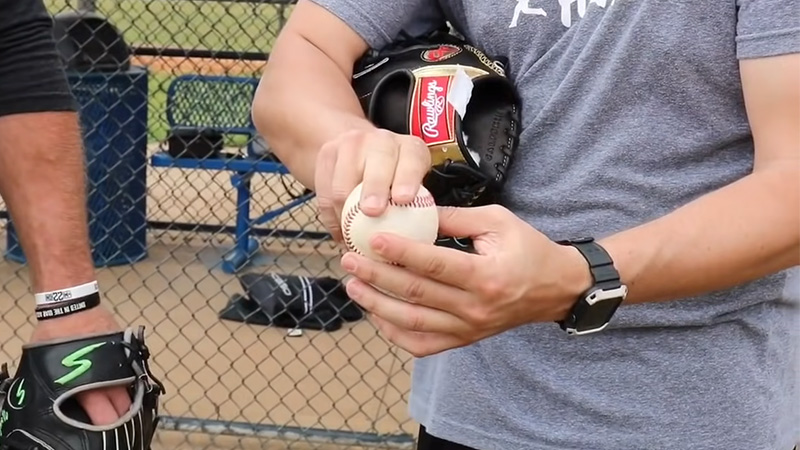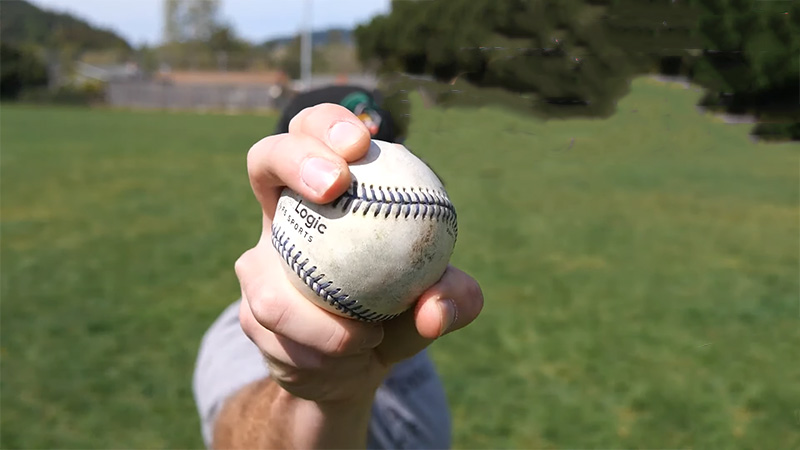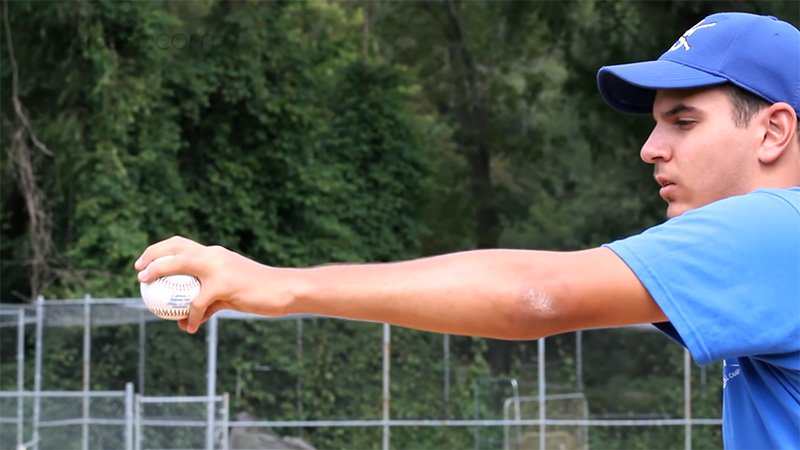Pitching is an art within the game of baseball. The ability to throw an array of pitches with precision, control, and deception is what sets exceptional pitchers apart.
From the blazing fastballs to the mind-bending breaking balls and the crafty changeups, pitchers have a repertoire of pitches at their disposal to outwit and overpower opposing hitters.
We will examine the mechanics behind each pitch, including grip variations, release points, and the strategies employed to maximize their effectiveness.
So, let’s step onto the pitcher’s mound, explore the artistry of pitching, and uncover the secrets behind the pitches that make baseball an exhilarating and captivating sport.
12 Types of Baseball Pitches
Usually, Baseball Pitches are of 12 different types. They are discussed briefly right below.
1. Four-Seam Fastball

The four-seam fastball is the most common and fundamental pitch in a pitcher’s repertoire. It is known for its high velocity and minimal movement, making it a go-to pitch for challenging hitters.
The grip for a four-seam fastball involves placing the fingers across the horseshoe-shaped seams, with the thumb positioned underneath the ball.
When throwing a four-seam fastball, the pitcher aims to generate maximum velocity and maintain a straight trajectory toward the catcher’s mitt.
The grip allows for greater control, as the pitcher can put more force behind the pitch while maintaining accuracy. Additionally, the grip promotes backspin, which helps the ball carry through the air with less resistance.
The four-seam fastball is particularly effective in situations where power and velocity are key, such as when trying to blow a pitch by a batter or when needing a strikeout.
It is often the first pitch a pitcher master, as it sets the foundation for developing other pitches. However, despite its simplicity, it requires proper mechanics and consistent release points to achieve desired results.
2. Two-Seam Fastball

The two-seam fastball, also known as a sinker, is a pitch that offers natural movement and is designed to induce ground balls. It is distinguished by its downward sinking action and lateral movement towards the throwing arm side.
The grip for a two-seam fastball involves gripping the ball along or between the seams using the index and middle fingers.
When throwing a two-seam fastball, the pitcher aims to generate sinking and running movement, making it challenging for batters to make solid contact.
The grip and arm action cause the ball to rotate differently than the four-seam fastball, resulting in a downward movement that can induce ground balls and weak contact.
The two-seam fastball is a valuable pitch for inducing double plays and keeping the ball in the infield. It is often favored by pitchers who prioritize inducing ground balls over strikeouts.
Due to its movement, it can be challenging for hitters to square up and lift, leading to more ground ball outs and fewer fly balls.
To effectively throw a two-seam fastball, pitchers must focus on proper grip, release point, and arm action.
3. Cutter

The cutter, also referred to as a cut fastball, is a pitch that combines velocity with slight lateral movement. It is designed to break in on same-handed hitters or away from opposite-handed hitters.
The grip for a cutter is similar to that of a fastball, but the fingers are slightly off-center on the inside of the ball, giving it a different spin.
When throwing a cutter, the pitcher aims to create a late-breaking movement that surprises the hitter. The slight alteration in grip and release point causes the ball to cut in sharply, often leading to weak contact or inducing a batter to jam themselves.
The cutter can also be thrown with backdoor movement, starting outside the strike zone and then catching the edge for a called strike.
4. Splitter

The splitter is a deceptive pitch that combines elements of a fastball and a forkball. It is known for its late downward movement, making it a devastating pitch for inducing swings and misses.
The grip for a splitter involves holding the ball with the index and middle fingers split apart, creating a split in the airflow around the ball.
When throwing a splitter, the pitcher aims to deceive the batter by mimicking the arm action and speed of a fastball. However, upon release, the split-finger grip causes the ball to dive downward dramatically as it approaches the plate.
This downward movement can cause hitters to swing over the top of the ball or make weak contact.
The splitter requires precise control and finger strength to execute effectively. Pitchers must focus on maintaining consistent arm speed and release point to keep the pitch sharp and unpredictable.
Due to its late downward movement, the splitter is often used as a strikeout pitch, particularly against hitters who have difficulty handling breaking balls or off-speed pitches.
5. Forkball

Forkball is a deceptive and effective pitch known for its significant downward movement. It is thrown with a unique grip where the ball is held deep in the hand, wedged between the index and middle fingers.
The grip allows the pitcher to generate a backspin and create a sharp downward break as the ball approaches the plate.
When throwing a forkball, the pitcher uses a similar arm action to a fastball but with a slightly modified grip. The grip and release of the ball cause it to dive rapidly, resembling a sinking fastball or a splitter.
The downward movement of the forkball can deceive hitters, leading to swings and misses or inducing weak ground balls.
Pitchers who utilize the forkball effectively can keep hitters off balance and induce a high number of ground ball outs.
The grip and arm action required to throw a forkball can take time to master, but once perfected, it becomes a valuable weapon in a pitcher’s arsenal.
6. Curveball

The curveball is a slow-breaking pitch that is known for its significant downward and lateral movement. It is a favorite among pitchers for its ability to deceive batters and induces swings and misses.
The grip for a curveball involves bending the wrist and snapping it upon release, creating a topspin and spin axis that generates the pitch’s characteristic movement.
When throwing a curveball, the pitcher aims to create a trajectory that initially appears as a fastball before breaking sharply downward. The spin and arm action cause the ball to rotate on a vertical axis, resulting in a pronounced drop as it approaches the plate.
This downward movement makes it challenging for batters to make solid contact and often leads to swings that miss the ball entirely or result in weakly hit grounders or pop-ups.
The curveball is an effective pitch to disrupt a hitter’s timing and keep them off-balance. It can be used as a strikeout pitch or to induce ground balls.
The speed differential between the curveball and a pitcher’s fastball further adds to its deception, making it an essential weapon in a pitcher’s arsenal.
7. Slider

The slider is a breaking pitch that combines velocity and lateral movement. It is thrown with a grip similar to a fastball but with the pitcher’s index and middle fingers slightly off-center on the ball.
The goal of the slider is to create a sharp, late-breaking movement that moves away from same-handed hitters or in on opposite-handed hitters.
When throwing a slider, the pitcher aims to generate spin and side-to-side movement. The grip and arm action cause the ball to rotate on a horizontal axis, resulting in a sweeping or slurve-like trajectory as it approaches the plate.
This movement can be difficult for batters to track and can induce swings and misses or weak contact.
The slider is a versatile pitch that can be used to jam hitters inside or break away from their swing path. It can be thrown for strikes or as a chase pitch out of the strike zone.
The combination of speed and movement makes it an effective complement to fastballs and changeups, keeping hitters off-balance and guessing.
8. Slurve

The slurve is a breaking pitch that combines the characteristics of a slider and a curveball. It is known for its sweeping movement and sharp break.
The grip for a slurve is similar to a curveball, with the pitcher placing their fingers across the seams for a firm grip.
When throwing a slurve, the pitcher aims to generate a pitch that falls between a curveball and a slider in terms of movement and velocity. The slurve typically has a sharper, more lateral break than a curveball but is not as sharp as a slider.
The combination of horizontal movement and downward break makes it a challenging pitch for hitters to track and make solid contact with.
The slurve is often used as a strikeout pitch or to induce weak ground balls. Its break and movement can deceive hitters, causing them to swing early or misjudge the pitch’s location.
However, due to its unique movement, the slurve requires precise control and consistency in execution to ensure it remains in the strike zone and doesn’t hang over the middle of the plate, where it can be vulnerable to hard-hit balls.
9. Screwball

The screwball is a unique and uncommon pitch known for its pronounced movement, breaking away from same-handed hitters. It is typically thrown by left-handed pitchers to right-handed hitters and vice versa.
The grip for a screwball involves holding the ball with the index and middle fingers positioned on one side of the ball, applying pressure to create spin and movement.
When throwing a screwball, the pitcher employs a snapping motion that generates a combination of downward and lateral movement. The spin applied to the ball causes it to break sharply away from same-handed hitters, making it challenging to make solid contact.
The screwball’s movement can be similar to that of a slider or curveball but with a distinct opposite break.
The screwball is a challenging pitch to master, as it requires precise control and consistent mechanics. Due to its unique movement and rarity, it can catch batters off-guard, resulting in swings and misses or weakly hit balls.
However, the screwball is known to put additional stress on the arm and is associated with a higher risk of injury, which has led to its decline in popularity in recent years.
10. Changeup

The changeup is a deceptive pitch designed to disrupt a hitter’s timing by mimicking the speed of a fastball while reducing its velocity.
It relies on the pitcher’s ability to change arm speed and grip to create the illusion of a fastball, only for the pitch to arrive at a significantly slower pace. The changeup is an effective off-speed pitch that keeps batters off-balance and induces weak contact.
The grip for a changeup can vary, but the common factor is the pitcher’s intention to reduce velocity. Grips such as the circle changeup, three-finger grip, or even modified fastball grips are used.
The key is to maintain a firm grip while keeping the ball deep in the hand, reducing the force exerted upon release.
To throw a changeup, the pitcher must focus on altering arm speed and maintaining consistent arm action with their fastball delivery. This deceptive element is what causes the hitter to be out in front of the pitch, expecting a faster delivery.
The changeup’s effectiveness lies in its ability to disrupt a hitter’s timing and create a significant difference in speed compared to the pitcher’s other pitches.
11. Palmball

The palmball is a rare and unique pitch that relies on the pitcher gripping the ball deep in the palm of their hand. This grip reduces the pressure on the ball, resulting in reduced velocity and a significant change of pace.
The palmball is often thrown with a fastball arm action to deceive hitters, as its reduced speed can catch them off-guard.
The grip for a palm ball involves placing the ball deep in the palm, typically using the pads of the fingers to hold it in place.
This grip, coupled with a loose grip, creates minimal friction and results in a slower pitch. The release of the palmball is similar to a fastball, giving it an element of surprise.
When executed properly, the palmball can create significant deception, as its reduced velocity can cause hitters to swing early or misjudge the timing.
The pitch’s slower speed and change of pace make it effective for inducing weak contact or pop-ups, as batters struggle to adjust their timing and generate the necessary power.
12. Circle Changeup

The circle changeup is a variation of the traditional changeup pitch that relies on a unique grip and arm action to deceive hitters.
It is called the “circle” changeup due to the grip formed by the pitcher’s index finger and thumb, creating a circle or “OK” sign. The remaining fingers rest comfortably on the ball.
When throwing a circle changeup, the pitcher aims to mimic the arm speed and delivery of a fastball, creating the illusion of a fastball pitch to the hitter.
However, the grip and release generate reduced velocity and added movement, making it challenging for batters to time and make solid contact.
The circle changeup is effective due to its ability to generate arm-side movement, typically sinking or running away from same-handed hitters. The reduced velocity and movement can induce swings and misses or weakly hit balls.
Pitchers who master the circle changeup can use it as a valuable off-speed pitch to keep hitters off-balance and generate ground balls or strikeouts.
Types of Baseball Pitches: At A Glance
| Pitch Type | Description | Movement | Notable Pitchers |
| Four-seam Fastball | Fastest, straightest pitch | Little to no movement | Aroldis Chapman, Jacob deGrom |
| Two-Seam Fastball | Downward movement, can run in on RHH | Slight downward, some running movement | Justin Verlander, sinkerballers |
| Cutter | Breaks away from RHH, faster than a slider | Lateral movement breaks away | Mariano Rivera, Kenley Jansen |
| Splitter | Sudden downward break before reaching the plate | Dramatic downward movement | Roger Clemens, Mike Scott |
| Forkball | Gradual downward movement | Less dramatic than Splitter | Hideo Nomo, Masahiro Tanaka |
| Curveball | 12-6 top-to-bottom movement | Top-to-bottom break | Sandy Koufax, Clayton Kershaw |
| Slider | Downward and away movement from RHH | Sharp, lateral break | Randy Johnson, Chris Sale |
| Slurve | 11-5 movement, similar to curveball | Diagonal break between curve and slider | Bert Blyleven, Barry Zito |
| Screwball | 1-7 movement, opposite of slurve | Reverse break | Carl Hubbell, Fernando Valenzuela |
| Changeup | Slower than a fastball, deceptive speed | Minimal movement | Pedro Martinez, Johan Santana |
| Palmball | Gripped tightly in the palm | Minimal movement, reduced velocity | Jamie Moyer, Jared Weaver |
| Circle Changeup | Grip forms a circle with the index finger | Late movement, drop, or fade | Trevor Hoffman, Cole Hamels |
FAQs
Are there any other types of breaking pitches besides the curveball, slider, slurve, and screwball?
Yes, there are additional breaking pitches such as the knuckle curve, which combines the grip of a knuckleball with the mechanics of a curveball. Another example is the knuckleball itself, known for its unpredictable and fluttering movement. Additionally, some pitchers may develop their unique breaking pitches with varying degrees of success.
Can pitchers throw multiple variations of the same pitch?
Yes, pitchers often experiment with different grips, arm angles, and release points to create variations of their primary pitches. For example, a pitcher may throw a hard slider with a late, sharp movement, as well as a slower, sweeping slider with a more gradual break. These variations can keep hitters off balance and add depth to a pitcher’s arsenal.
How do pitchers determine which pitch to throw in a given situation?
Pitch selection depends on various factors, including the count, the hitter’s strengths and weaknesses, and the pitcher’s repertoire. Pitchers and catchers work together to analyze scouting reports, study hitters’ tendencies, and make educated decisions on pitch selection. They aim to exploit weaknesses, disrupt timing, and keep hitters guessing throughout an at-bat.
Can pitchers mix different types of pitches within a single pitch sequence?
Absolutely. Pitchers often use a combination of pitches to create a more effective sequence and keep hitters off balance. For instance, they may start with a fastball to establish velocity, follow up with a breaking ball to change the eye level and disrupt timing, and finish with a changeup to deceive the hitter with a change in speed.
Conclusion
The world of baseball pitching is filled with a fascinating array of pitches, each with its unique characteristics and challenges.
From the blazing fastballs to the mesmerizing breaking balls and the deceptive changeups, pitchers have a wide range of weapons at their disposal to keep hitters off balance and gain the upper hand on the mound.
Throughout this guide, we have explored the different types of pitches, delving into their descriptions, movements, and notable pitchers who have mastered them. Thank you for being with us.







